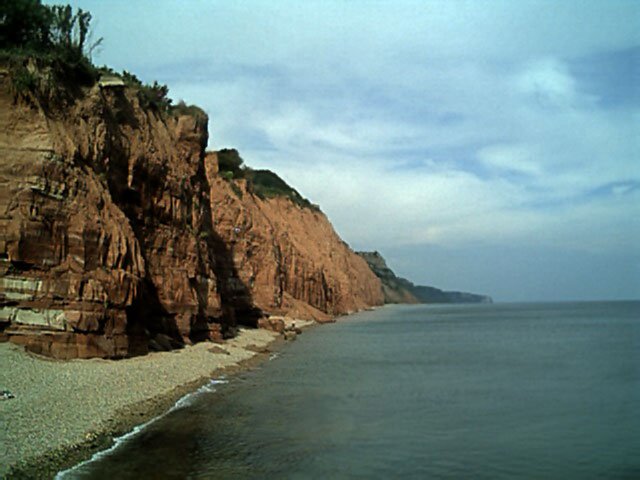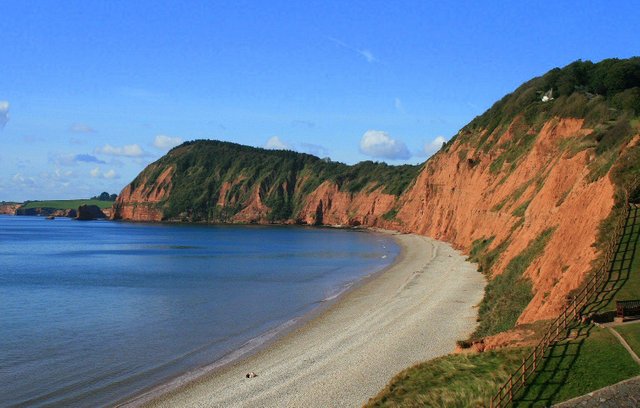Visiting Sidmouth - a pretty resort on the Devonshire coast.

Sidmouth is a traditional, unspoiled resort where panama hats outnumber baseball caps and the weather knows how to behave. Back in the late 1700s the locals’ longevity was put down to the good sea air, so the aristocracy made this part of the coast a fashionable place to enjoy “the situation most delicious”.
The richest built their own grand houses and as the number of visitors grew, soon fishermen, preparing their nets on the shingle shore, looked up to see grand seafront houses and hotels being built.
No doubt the salty dogs grumbled as the buildings rose, but fortunately for us, Georgian architects were possessed with a sense of proportion and rhythm, resulting in the line of fine structures, including the Hotel Riviera. It was on the seafront terrace of this elegant hotel that John Betjeman jotted notes for his “lost” poem, “Still Sidmouth”.
I suspect if the laureate visited today he would see very few changes, apart from a few recent rocky breakwaters. Whilst most hotels stand square to the sea, the Riviera is set back a little, allowing sunny seafront dining. Its superb aspect captivated Sidney Wharton who, in 1973, exchanged life as a Bristol shopkeeper for that of a seaside hotelier. More than 40 years later, his son Peter is still in charge of this delightfully comfortable institution.
Regency visitors would stay for months, but today’s holidaymakers come for a week or two’s relaxation. There are plenty of benches along the seafront esplanade, yet canvas This week’s cover feature deckchairs offer the most relaxing alternative. At only £8 a week to hire they are a bargain, especially if you have a thick book to get through.
Sportier visitors have plenty of outlets, most noticeably on the town’s many croquet lawns, bowling greens, tennis courts, golf course and Fortfield’s cricket pitch. As its name implies, this was once the site of a military base. Today the wonderful thatched pavilion is the ideal spot to watch locals thwack leather with willow.

It is also a good viewpoint to appreciate Fortfield Terrace, which hints at the resort’s royal origins. In 1831 the Russian Czar’s sister-in-law, Grand Duchess Helena, rented Number 8. An imperial eagle commemorates this royal visit. Earlier, Number 1 was owned by Lord Gwydir. When the Lord later became Chamberlain to the Prince Regent, he moved to Old Hayes – now the Woodlands Hotel, whose bubblegum pink dormer decoration must be seen to be believed.
Not all royal visits went well. In December 1819 the Duke and Duchess of Kent arrived to stay at Woolbrook Cottage with their daughter, Victoria, but the Duke fell ill, expiring in the New Year. A more recent, happier royal connection left a legacy still enjoyed by locals and visitors alike. Queen Victoria’s third son, the Duke of Connaught, visited in the early 1930s. A few years later, Connaught Gardens were opened above the town’s loveliest beach. Jacob’s Ladder beach is where the red cliffs of the Jurassic Coast rise again on their journey west towards Budleigh Salterton.
The ladder refers to the wooden staircase up to the gardens, where the courtyard below the clock tower hosts a very popular tearoom. A Sunday evening stroll to the park is rewarded with band concerts, a tradition which started in the 1860s! Keen walkers continue along the coast path, but we drove a mile or so east towards Salcombe Regis, where a short, flat walk leads to a clifftop view. A heat haze and overgrown trees obscured much of the coastal scenery, but it was a lovely location to rest on one of the many benches, or enjoy a downhill stroll back to the Esplanade.

We drove back, however, splashing through the ford into town, where we met one of the town’s characters. It was Steve Cox’s accent, that of my childhood Cardiff, I recognised first. After establishing we didn’t have any mutual friends, he told us how his quest for an alternative lifestyle had brought him to Sidmouth via Glastonbury. “I have lived here for just over a year and like it,” he told us between tunes on his guitar, which he played very well.
Steve suggested a few walks, including the Byes. “It’s beautiful: through woodland, beside the River Sid up to Sidford.” We followed Steve’s suggestion and on our way diverted up Hillside Road, opposite the pretty tollhouse, where beside a bank filled with valerian flowers we found a clutch of idyllic thatched cottages. You don’t have to leave Sidmouth to see pretty Devon village. Beyond Sidford, the lovely village of Sidbury can be reached comfortably on foot, but our aim was to make the most of Sidmouth itself.
Each week, free guided walks set out from the museum, where volunteers lead an amiable amble around the town. Whilst nature lovers follow the river or coast, history buffs can follow blue plaques which note memorable places and events. Over breakfast our neighbours recalled their previous day’s hike along the coast to Beer. “With all the up and downs, I reckon it was the equivalent of climbing Snowdon!” The husband laughed. After popping into the church we sought out Coburg Terrace, opposite tennis courts and bowling greens.
Poet Elizabeth Barrett, who married Robert Browning, lived nearby before moving with her family to live in London. Wandering the town centre is made more pleasant by light traffic. There are lots of places to pause and watch the world go by, but if spending is on the agenda, most shops are small, local enterprises.
Even Fields, the local department store, is on a human scale, curving on a street corner opposite the old Market Hall. Inside, beside the fishmonger, is a fruit and vegetable stall with the widest, most delicious range of fresh produce you could hope to find anywhere. As if to compete, the comestible delights in Hayman’s Butcher’s window vie for shoppers’ attention with floral hanging baskets.
We like rooting in antiques shops as we can’t resist lovely, useful old things – a bit like me.. I then pointed my camera at a rainbow of glass by the shop’s back window. The owner was delighted at my interest and, like so many people in this town, was happy to while away part of the day in chat. When a young couple walked past licking two ice-creams she pointed us in the direction of Taste, a few doors down. “They sell local ices and are very good,” we were assured.

I was a few licks into my chocolate cone when I was mugged. Before I knew what was happening, a shape dive-bombed me over my shoulder and I was left holding the pieces of broken cone. On the pavement, a greedy seagull was trying to fly away with the remains of my frozen delight. “They used to have a hawk which kept the seagulls away,” a witness told us, “but I think that went with government cuts.” The town’s museum is in Hope Cottage, a building donated by Miss Constance Radford. She is not Sidmouth’s only generous benefactor.
In more recent times, Canadian Keith Owen, who planned to move here, bequeathed £2.3 million to Sidmouth, the interest on which has been used on a number of projects including the colourful fish mural and a project close to conservationist Keith’s heart. “Think big, plant a million bulbs – get everyone involved.” This benevolent thought has led to the town being carpeted in springtime colour.
After another night accompanied by the soothing sound of lapping waves and rolling shingle, we took a final stroll along the Esplanade, where we found artist Neil Hanson capturing the panorama on canvas. Neil, who hails from Lancashire, now calls Sidmouth home and exhibits his work in the gallery next to Costa Coffee. Before checking out from the Hotel Riviera we took the back lane, past an ancient Tudor cottage, then up Old Fore Street.
On the surface it is certainly charming and pretty, but look just a little further and it is a really interesting place.
P.S. All the travels posted by me are imaginary but the historical facts are true :)
Follow for more...
Imaginary travel... interesting lol i guess if you can't be there this is the next best thing
Yes that's what it is ;)